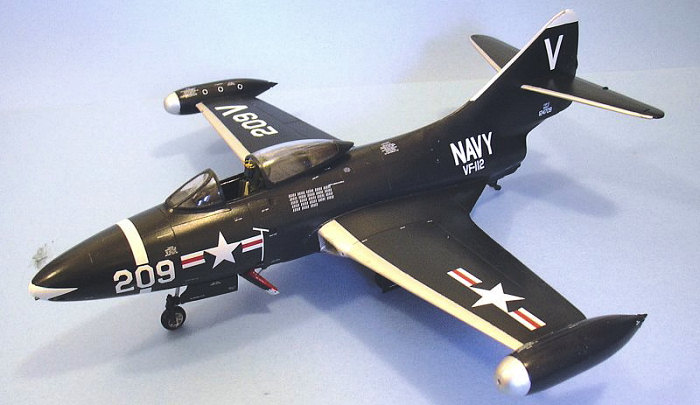
Fisher Model Products 1/32 F9F-2 Panther
| KIT: | Fisher Model Products 1/32 F9F-2 Panther |
| KIT #: | ? |
| PRICE: | $195.00 |
| DECALS: | Four options |
| REVIEWER: | Tom Cleaver |
| NOTES: | Resin multimedia kit |

| HISTORY |
What became the Grumman Panther was first designed as a four-jet night fighter that resembled the Curtiss XF-87 Nighthawk. This was due to the fact that early jet engine development under Navy sponsorship made a false start. One of the first engines available to Grumman designers at the end of the Second World War was the 1,500 lb thrust Westinghouse 130; in order to achieve the required performance it would be necessary to install four of these engines in the original Grumman design, which was designated XF9F-1. The development contract was issued on April 22, 1946, but further design work revealed that the airplane would not meet the specifications.
By
1947, the British Nene engine was available, producing nearly four times the
thrust of the Westinghouse engine. Grumman determined that using a single Nene
would allow them to produce a day fighter that had significantly better
performance than either the FH-1 Phantom or the FJ-1 Fury that were then in
limited operational use by the Navy. The Navy agreed and Pratt & Whitney
obtained a license to produce the British engine as the J-42. The designation
became XF9F-2, and my old friend (and fellow aviation writer nowadays) Corky
Meyer flew the first prototype on November 24,1947, powered by a Nene providing
5,750 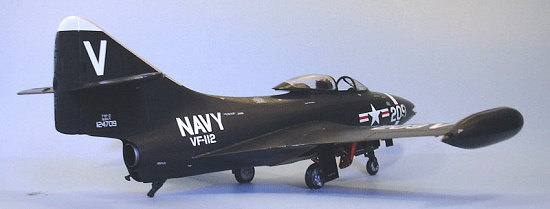 pounds of thrust. The
prototype was very close to “right” all the way around as originally flown,
other than needing permanently-mounted wingtip fuel tanks, which also improved
the roll rate. The F9F-2, now known as the “Panther,” was cleared for carrier
operation in September 1949 and entered service that November with VF-51.
pounds of thrust. The
prototype was very close to “right” all the way around as originally flown,
other than needing permanently-mounted wingtip fuel tanks, which also improved
the roll rate. The F9F-2, now known as the “Panther,” was cleared for carrier
operation in September 1949 and entered service that November with VF-51.
The entry of the Panther into service came just in time. Seven months later the airplane was involved in a shooting war following the North Korean invasion of South Korea on June 25, 1950. On June 27, President Truman authorized American forces to enter combat. USS “Boxer,” with VF-51 aboard, had moved into the Sea of Japan immediately following the outbreak of hostilities. The carrier launched the first Navy air strike that same day. VF-51's Panthers flew as fighter escort to the Corsair and Skyraider attack squadrons in a strike on the airfield at Pyongyang, the North Korean capitol.
On
July 3, LT(jg) Leonard H. Plog of VF-51 scored the first U.S. air victory of the
war when he shot down a North Korean Yak-9P. Two days later another Yak-9P was
shot down over Seoul. On November, 9, 1950 LCDR William Amen, CO of VF-111
"Sundowners" shot down a MiG-15 that was likely Soviet-flown when his division
was attacked while flying escort near the Yalu
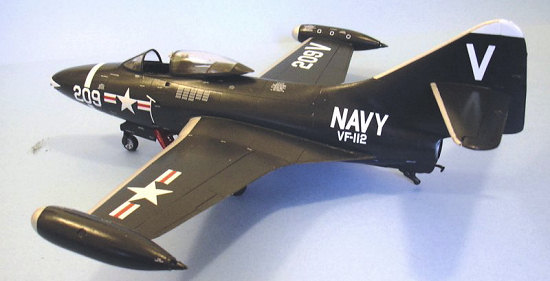 River within sight of the
Soviet base at Vladivostok. Amen reported that the MiG-15 completely outclassed
the F9F-2, and that he and his wingman had only barely been able to stay in
range behind the MiG he shot down, which had also proven quite resistant to the
fire of his 4 20mm cannon at long range. Two more MiG-15s were shot down on
November 18, 1950, while two more were shot down two years later to the day on
November 18, 1952. In all five cases, the victories were due to superior pilot
training and experience on the part of the Navy pilots. The Navy didn’t like
the results of these fights, which proved that their main fleet fighter was
outclassed by the opposition. The result was a crash program that saw a
“swept-wing Panther” (the Cougar) introduced to fleet service just too late to
see combat service in Korea.
River within sight of the
Soviet base at Vladivostok. Amen reported that the MiG-15 completely outclassed
the F9F-2, and that he and his wingman had only barely been able to stay in
range behind the MiG he shot down, which had also proven quite resistant to the
fire of his 4 20mm cannon at long range. Two more MiG-15s were shot down on
November 18, 1950, while two more were shot down two years later to the day on
November 18, 1952. In all five cases, the victories were due to superior pilot
training and experience on the part of the Navy pilots. The Navy didn’t like
the results of these fights, which proved that their main fleet fighter was
outclassed by the opposition. The result was a crash program that saw a
“swept-wing Panther” (the Cougar) introduced to fleet service just too late to
see combat service in Korea.
Despite its limitations, the Panther was the main naval jet aircraft used throughout the Korean War, flying 78,000 sorties between June 27, 1950 and July 30, 1953.
There are at least four F9F-2 Panthers left in existence, one on display at the Marine Corps Museum in Quantico, Virginia, one at the National Museum of Naval Aviation in Pensacola, Florida, one at NAS Willow Grove in Pennsylvania, and BuNo 123708, owned by the Cavanaugh Flight Museum in Addison Texas, which was restored to flight status in 1995 and is the only flying Panther in the world.
| THE KIT |
Unlike that waste of innocent plastic known as the Hobbycraft/Trumpeter F9F-2, this kit gets it right on all points. The Fisher Panther is the right length and is correctly-shaped everywhere. All in all, it is the only completely-accurate F9F-2 Panther kit ever offered for sale anywhere.
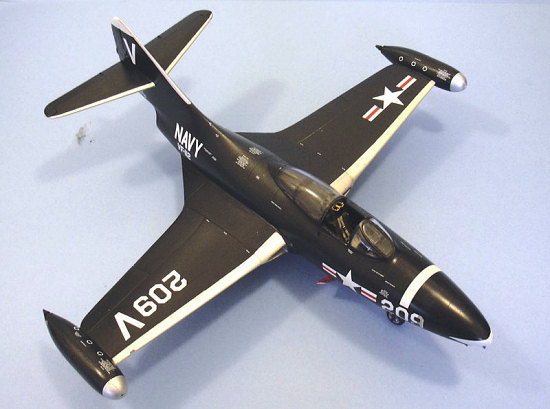 Those modelers lucky
enough to have built the other Fisher Grumman jets will appreciate that this kit
takes care of some problems that were found in the previous releases. Most
importantly, it comes with a one piece wing. 99.9999% of all Panthers seen on
the ground are seen with their flaps up. As Corky Meyer explained it to me, the
pilot was supposed to raise the flaps immediately on landing to make sure the
airplane stayed on the ground (or the flight deck), and to avoid any FOD damage
to the lower surfaces of the wing. This one-piece wing makes everything much
easier for those of us who wanted to do the model with the flaps up, since there
is no longer re-shaping, sanding down, filling gaps, sanding further, rescribing,
etc. The kit also includes separate rear tips to the wingtip tanks, so that the
fuel vent is open, as it should be.
Those modelers lucky
enough to have built the other Fisher Grumman jets will appreciate that this kit
takes care of some problems that were found in the previous releases. Most
importantly, it comes with a one piece wing. 99.9999% of all Panthers seen on
the ground are seen with their flaps up. As Corky Meyer explained it to me, the
pilot was supposed to raise the flaps immediately on landing to make sure the
airplane stayed on the ground (or the flight deck), and to avoid any FOD damage
to the lower surfaces of the wing. This one-piece wing makes everything much
easier for those of us who wanted to do the model with the flaps up, since there
is no longer re-shaping, sanding down, filling gaps, sanding further, rescribing,
etc. The kit also includes separate rear tips to the wingtip tanks, so that the
fuel vent is open, as it should be.
The kit provides sufficient armament and wing racks to do the early F9F-2, or the fighter-bomber F9F-2B.
Additionally, the kit provides detail parts to make an F9F-2KD drone controller.
Decals are provided for William T. Amen’s MiG-killer, an F9F-2 flown by my old Commanding Officer, VADM Damon W. Cooper, when he was CO of VF-91 aboard the Princeton in 1953, a grey-white Marine Reserve airplane, and a very colorful F9F-2KD drone controller used for the Regulus program from Point Mugu in 1958.
Those who have seen the previous kits don’t need to be told that the cockpit is fully detailed.
The canopy is separate, molded in clear resin and already dipped in Future for maximum clarity.
| CONSTRUCTION |
The hallmark of any kit produced by Paul Fisher is buildability, and this Panther is no exception. It goes together just like the F9F-5 Panther, other than you don’t have to worry about the flaps.
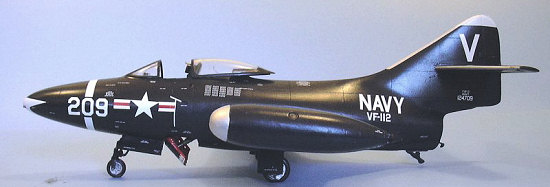 “Construction begins
with the cockpit,” as they say. The painting instructions are right, and one
can add as much detail with a paintbrush here as they choose. Glue the ten
pennies in position for nose weight, then slide the cockpit into position inside
the fuselage and glue it in position with cyanoacrylate glue. There are gaps,
which I filled with white glue and then hid with paint.
“Construction begins
with the cockpit,” as they say. The painting instructions are right, and one
can add as much detail with a paintbrush here as they choose. Glue the ten
pennies in position for nose weight, then slide the cockpit into position inside
the fuselage and glue it in position with cyanoacrylate glue. There are gaps,
which I filled with white glue and then hid with paint.
Due to resin molding, some wings may not fit as closely to the fuselage as they should. This is just a matter of fact - resin casting is more art than science. Some wings fit perfectly and all you have to do is fill the seams with C-A glue, cover them with Mr. Surfacer 500, and sand smooth. Some wings will leave gaps. As they say, “test fit three times before gluing once.”
I
got one of the ill-fitting wings. The thing to do to solve this is to be sure
you mate the wing so that it aligns with the lower surfaces of the fuselage. I
used some 10 -mil sheet styrene
along the mating surface of the fuselage, which resulted in a wing that aligned
perfectly to the lower surfaces. I then filled the fairly-substantial gaps with
cyanoacrylate glue, which I allowed to dry “naturally” before I covered it with
Mr. Surfacer 500. I then sanded this smooth with sanding sticks. This is
merely an exercise in basic modeling skills, and takes maybe 20 minutes of
careful sanding after letting the Mr. Surfacer cure for a few hours.
-mil sheet styrene
along the mating surface of the fuselage, which resulted in a wing that aligned
perfectly to the lower surfaces. I then filled the fairly-substantial gaps with
cyanoacrylate glue, which I allowed to dry “naturally” before I covered it with
Mr. Surfacer 500. I then sanded this smooth with sanding sticks. This is
merely an exercise in basic modeling skills, and takes maybe 20 minutes of
careful sanding after letting the Mr. Surfacer cure for a few hours.
Past that, the kit presented no problems. I particularly liked the white metal landing gear. Both this new gear and the original resin gear is provided. My F9F-5 with resin gear is still sitting right 4 years later, so it’s your call. I went with the assurance of the white metal gear.
| COLORS & MARKINGS |
Painting:
The leading edges of all flying surfaces on the Panther were painted with silver
Coroguard. I gave the area a “primer” of Tamiya Flat Aluminum, then applied
Talon “Platinum.” I then masked these areas off and painted the model with
Xtracrylix “Glossy Sea Blue.” I have seen modelers try to “sun fade” GSB, and
it always looks wrong. Just go with the monochromatic color (which is right)
and be sure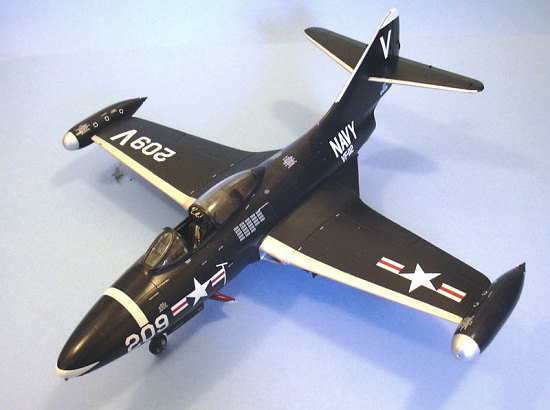 you have a nice
smooth surface, since any glitches will show up as you turn the model under
light and watch for under-the-paint goofs (and yes, I speak here from
experience).
you have a nice
smooth surface, since any glitches will show up as you turn the model under
light and watch for under-the-paint goofs (and yes, I speak here from
experience).
Decals:
The kit decals are great. I chose to do Bill Amen’s MiG-killer for historical reasons. Everything went down without problems under a coat of Micro-Set.
| FINAL CONSTRUCTION |
I used rockets from the Trumpeter P-47 kit - they were just easier than fiddling with the rockets in the kit since they are one-piece. The kit ordnance is fine. Do pay attention to the notes in the instructions so you don’t load your model with sufficient underwing weight to insure a cold cat shot and a quick trip to Davy Jones’ Locker. What’s left over is great stuff for the spares box.
I particularly enjoyed doing an early F9F-2 so I didn’t have to worry about painting the white canopy reinforcements that were later found necessary.
| CONCLUSIONS |
You can buy the 1/48 Hobbycraft/Trumpeter Panther, then spend $100+ on all the resin correction parts (that still don’t get everything right) and end up with a smaller model that costs about $30 less than this kit, or you can buy one of the two best Panther kits ever made (the other being the Fisher F9F-5) and have something to put on the shelf that will definitely Attract Attention. It depends on how much you like the coolest Grumman Navy jet (I like it a whole lot). It’s a kit that requires nothing more than basic skills to create a Master-Class model.
Review Kit courtesy of Paul Fisher.
December 2007
If you would like your product reviewed fairly and quickly, please contact me or see other details in the Note to Contributors.